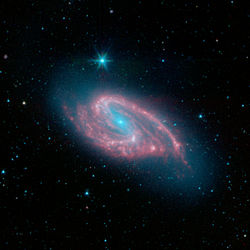Messier Index/M66
Appearance
| Messier 66 | |
|---|---|
 M66 as observed with the w:Spitzer Space Telescope as part of the SINGS. The image is a four-channel false-color composite, where blue indicates emission at 3.6 micrometers, green corresponds to 4.5 micrometers, and red to 5.8 and 8.0 micrometers. The contribution from starlight (measured at 3.6 micrometers) in this picture has been subtracted from the 5.8 and 8 micrometer images to enhance the visibility of the w:polycyclic aromatic hydrocarbon emissions. | |
| Observation data (w:J2000 epoch) | |
| Constellation | Leo |
| Right ascension | 11h 20m 15.0s[1] |
| Declination | +12° 59′ 30″[1] |
| Redshift | 0.002425 (727 ± 3 km/s)[1] |
| Distance | 36 +/- 5.0 Mly (11.0 +/- 1.5 Mpc |
| Type | SAB(s)b[1] |
| Apparent dimensions (V) | 9.1′ × 4.2′[1] |
| Apparent magnitude (V) | 8.9[2] |
| Notable features | Galaxy in the w:Leo Triplet |
| Other designations | |
| NGC 3627, UGC 6346, PGC 34695, Arp 16[1] | |
Messier 66 (also known as NGC 3627) is an w:intermediate spiral galaxy about 36 million w:light-years away in the w:constellation Leo. It was discovered by w:Charles Messier in w:1780. M66 is about 95 thousand light-years across[3] with striking dust lanes and bright star clusters along sweeping spiral arms.[4] M66 is part of the famous w:Leo Triplet, a small w:group of galaxies that also includes M65 and w:NGC 3628.
History


Gravitational interaction from its past encounter with neighboring NGC 3628 has resulted in:
- An extremely high central mass concentration;
- A high molecular to w:atomic mass ratio;
- A resolved noncorotating clump of w:H I material apparently removed from one of the w:spiral arms.
This third result shows up visually as an extremely prominent and unusual spiral arm and dust lane structures as originally noted in the w:Atlas of Peculiar Galaxies.[4]
External links
References
- ↑ a b c d e f "NASA/IPAC Extragalactic Database". Results for NGC 3627. Retrieved 2006-08-31.
- ↑ G. de Vaucouleurs, A. de Vaucouleurs, H. G. Corwin, R. J. Buta, G. Paturel, P. Fouque (1991). Third Reference Catalogue of Bright Galaxies. New York: Springer-Verlag.
{{cite book}}: CS1 maint: multiple names: authors list (link) - ↑ 36.2 mly × tan( 9′.1 ) = ~96 kly. radius
- ↑ a b Zhang, Xiaolei; Wright, Melvyn; Alexander, Paul (1993). "High-Resolution CO and H i Observations of the Interacting Galaxy NGC 3627". Astrophysical Journal. 418: 100. doi:10.1086/173374.
{{cite journal}}: CS1 maint: multiple names: authors list (link)
